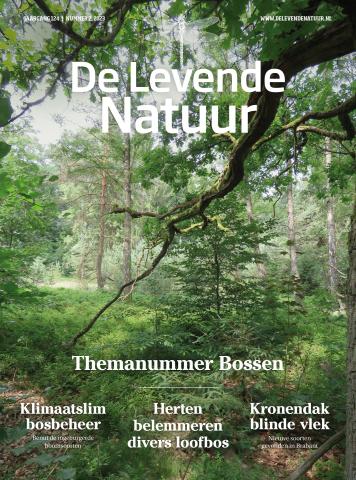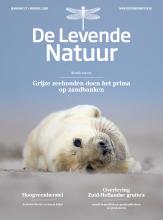De Levende Natuur nummer 2 van 2023 (English summary)
Afbeelding

Deer stand in the way of a diverse deciduous forest
Jan den Ouden
Dutch forest policy aims to increase the share and diversity of deciduous tree species in forests. The realization of this goal is strongly hampered by high population densities of wild ungulates, especially cervids. A recently started monitoring project in the Veluwe provides insight into the consequences of the recent sharp increase in grazing pressure. The amount of browsing appears to depend mainly on the density of red deer. Deciduous trees are browsed so intensively that their regeneration is seriously hampered. An increasing density of wild ungulates leads to a decrease in the diversity in deciduous trees, but not in coniferous trees. A continuous regeneration and increase in diversity of deciduous trees is only possible after the density of ungulates is reduced.
Hydrological restoration in loamy forests in North Brabant
Rob van der Burg, Louise Franssen, André Jansen & Dirkje Verhoeven The loamy forests of North Brabant are among the species richest forests of The Netherlands. However, drainage of the wet soils and construction of raised ridges drained by ditches (so called ‘rabatten’) has led to forest degradation due to desiccation and acidification and to the decline of its floristic richness. Since implementation of restoration measures might induce tree mortality and the loss of relict populations of rare species, foresters often are reluctant to take measures. Nevertheless, restoration is necessary to preserve and restore these species rich forests. Our study shows that restoration of local hydrological conditions is effective and feasible, resulting in increased groundwater levels and restoring the local relief. With this the basis has been laid for restoration of the loamy forest.
Introduced tree species play an important role in climate-smart forest
Bart Nyssen, Jan den Ouden, Etiënne Thomassen, Kris Verheyen & Bart Muys
Climate-smart forest management aims to adapt forests and forest management to preserve species diversity while maintaining or strenghtening ecosystem services like carbon sequestration and wood production. Our current tree species either reached us through natural migration or have been introduced. As new tree species are being considered in climate- smart forest management, the question arises as to what we can learn from previously introduced tree species. These introduced tree species are often considered second-class trees that contribute little or negatively to forest functioning. However, recent research shows that in addition to their originally intended function, they can also play an important role in forest climate adaptation and even in conservation of forest-associated species.
Fluctuations in Black Woodpecker in Drenthe
Willem van Manen
Around 1900 the Dutch province of Drenthe almost lacked woodland. Sand dunes were planted with Scots pine and heaths with larch, Norway spruce, douglas fir, sitka spruce and beech. In 1972 and 1973 storms destroyed much woodland, which was replanted. Forest management was limited to thinning. Around 2000 this changed, especially in Drents-Friese Woud, Hart van Drenthe and Dwingelderveld. The forests became wetter after filling in ditches, the age diversity increased after local clearfelling, the number of larches was decimated. Remaining patches of Norway spruce forest died after bark beetle outbreaks. Black woodpeckers breed in Drenthe since 1929. In the 1980s the population reached a peak of 100 pairs. Numbers declined again to about 60 pairs in the 1990’s and thereafter remained stable in pine woods on sandy soils, where they occurred in the highest densities in Dwingelderveld and Drents-Friese Woud. Also stable, but in a much lower density, was the population in other coniferous woodland without much management: Exloo/Odoorn, Sleenerzand and Emmen. Only in heavily degraded forests the number of black woodpeckers increased. The birds raised more young there. The decline in the 1990s was most likely due to a fading effect of the storms in 1972 and 1973.
Development of black cherry on West Terschelling since 1920
Herman Eijsackers
Black cherry was planted and sown on sandy soils in The Netherlands around 1920/1930. From there it dispersed, at first on sandy soils, later almost all over the country. It was therefore called ‘forest pest.’ Following research in the ‘90s, doubts arose about the massiveness of this dispersal. Therefore, the dispersal after planting and sowing has been investigated in an isolated situation on the isle of Terschelling. Inventories were carried out in 1977 and 2022 and compared to the original planting/sowing data. During 100 years (1920 to 2022), black cherry had dispersed to a limited extent through the forestry of West Terschelling, and at some places had disappeared completely. Unrestrained ‘pest’-like dispersal did not occur; in the second period the further dispersal had been very limited. Local germination of seedlings after logging or thinning is possible, although the seed remains germinative only for three to four years.
Insect diversity in Brabant’s tree crowns
Fabian Meijer, Jaap Bouwman, Tim Faasen & Jinze Noordijk
From tropical forests we know that tree canopies are one of the most diverse habitats in the world. Canopies in our temperate forests mostly are virgin territory to science. We investigated the arthropod biodiversity in a forest canopy in a Dutch forest, a poorly studied biotope in the Netherlands. We used three kinds of catching equipment to sample the canopies of Scots pine, pedunculate oak and small-leaved lime. The results show us that the canopies offer complex microhabitats where all sampled tree species contribute to the local biodiversity of the forest. In our research we recorded 31 new species for the area and even one new species for the Netherlands. The fact that we found these new species, even in rather young cultivated forests (former heathland), demonstrates how little we know about these arthropod communities in forest canopies. There is still much to discover!
Forgotten forests as inspiration for the future
Wouter Delforterie
Insight into the historical structure of the landscape and distribution of forest areas is an important base to achieve well founded forest landscape restoration. The total area of forest and woody landscape elements in Gelderland has considerably increased over the past 150 years. However, this obscures the regional deforestation that has taken place on the richer and humid soils, and the subsequent disappearance of ancient forests with their associated biodiversity. Current ambitions for forest expansion offer opportunities for restoring the natural qualities of these partly disappeared and forgotten forests. Historical maps provide insight into where valuable forest types may be restored and where they can contribute to the conservation, restoration and defragmentation of remaining ancient forest relicts.
A strategy for species-rich forests on former agricultural land
Leon van den Berg, Maaike de Graaf, Emiel Brouwer, Jaap Bloem & Lander Baeten
The Dutch government aims to enlarge its national forested area. A majority of the new woodlands will be planted on former farmland. We studied 64 afforested woodlands on former farmlands. These woodlands, on dry, sandy soils, varied from monotonous and dense spruce stands with a rich diversity of moss and mushrooms, to open and highly varied deciduous stands with a higher diversity of flora. Following the preceding arable land use, soils were levelled and lack variation in microrelief. In addition, these soils are rich in phosphorus and buffering as a result of fertilisation and liming. The diversity in plant species is lower in the acidified woodlands (Beech, Norway spruce) compared to the woodlands with more buffered soils. These differences are important in afforestation with the goal of increasing floristic biodiversity.

